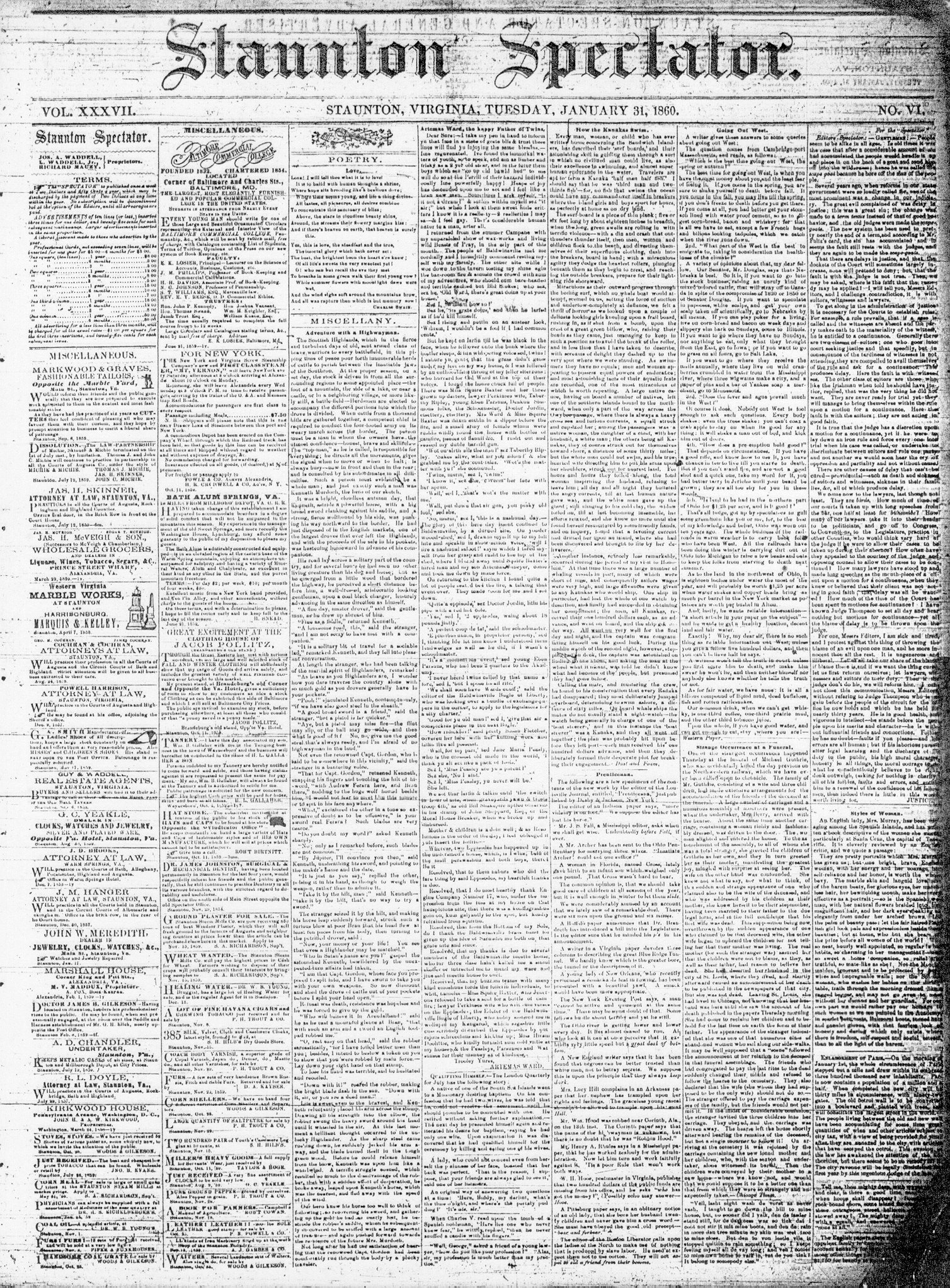|


Staunton Spectator: Jan. 31, 1860, Page 1

|

Staunton Spectator: Jan. 31, 1860, Page 1
|
|||||||
|
Columns 1-2: The head of column 1 was always the Spectator's masthead--its advertising and subscription terms, and the name of the publisher. The remainder of column 1, and most of column 2, were composed of small advertisements, running anywhere from one to ten lines of text. These brief inserts were almost entirely sponsored by individuals from Staunton offering their professional services or announcing that their stores had received new goods for sale. Larger ads occupied the top half of column 2. These could be local, but might also be sponsored by businesses as far away as New York or Baltimore |
 |
|
Column 3: The head of column 3 generally carried a short poem. The poetry could be anonymous or attributed, and sometimes was simply reprinted from another periodical such as the Southern Literary Messenger. Below the poem, the heading "Miscellany" introduced the remainder of page 1. The first item of miscellany was usually a long article. It could be political, but more frequently was a "human interest" piece dealing with an aspect of the history or culture of a foreign nation. The January 31 miscellany section, for example, began with an item describing an "Adventure with a [Scottish] Highwayman." Sometimes column 3 would carry more advertisements, similar in composition, style, size, and origin to those in column 2. When the Spectator had enough advertising to be laid out in this fashion, poetry and the miscellany section began in column 4. |
|
|
Columns 4-7: These columns had no set pattern. They tended to comprise a number of large and small news pieces, selected from newspapers of other states by the editor of the Spectator, who believed they would be interesting or amusing to his readers. These articles could deal with political issues, but more frequently they described unusual events, current national trends, or international history or "flavor" such as that which often appeared in column 3. These columns might also carry additional poetry or pieces of short fiction. In the January 31 issue, for example, the editor chose a fictional "letter" from "Artemas Ward." Written in the "dialect" of a poor white, it describes the birth of twins to the Ward family. Also appearing was a piece from the Chicago Times describing surprising events at a funeral, an article from a periodical called Dust and Foam describing the use of "surf boards" by people in the Sandwich Islands, and an item from the Western Paper giving advice for travel in the American West. |
|
|
These columns also contained any number of aphorisms and short jokes, designed to provide a light-hearted element to the newspaper. These usually relied on puns or other plays on words for their effect. Sometimes these pieces were bits of moral advice and commentary, such as hints for child-rearing or suggestions on how a "lady" should act. |
 |
|
There was very little pattern to the selection or inclusion of these short items. They always appeared at the foot of a column, and primarily served to fill out space where a longer piece might not fit. Filling a paper with material without having articles stretch beyond a single column could be a tricky task, and was generally left to the discretion of the printer. As the editor of the Spectator noted on February 28, 1860, with regard to the placement of letters to the editor, "We never indicate to the printer in what part of the paper to place such matter, but he arranges it solely with reference to convenience in making up the form." (This helps explain the appearance on page 1, column 7, of the January 31 issue of a letter to the editor regarding the upcoming judicial election. Letters to the editor usually appeared elsewhere.) |
 |